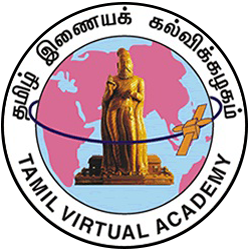Primary tabs
LESSON - 4
D02124 Ozhibiyal- I
(Nambi Agaporul - Varaiviyal, Karpiyal, Ozhibiyal)
This lesson throws light on ‘Ozhibiyal’, the last chapter of ‘Nambi Agaporul’. As this last chapter contains all the details and ideas left unsaid in the previous 4 chapters, it is called ‘ozhibiyal’. The term ‘ozhibiyal’ springs from ‘sollathu ozhintha’, meaning ‘left unsaid’. This lesson focuses on ‘agapaattu uruppugal’ or the various aspects of agam poetry discussed in ‘ozhibiyal’.
According to Naarkavirasa Nambi ‘agappattu’ or agam poetry has 12 aspects. They are ‘tinai’, ‘kaikol’, ‘kootru’, ‘ketpor’, ‘idam’, ‘kaalam’, ‘payan’, ‘munnam’, ‘meyppaadu’, ‘echam’, ‘porul vagai’ and ‘turai’. Of these the first 6 ie (tinai to kaalam) are related to the tinai. They are in someway linked to the landscape against which the poem is set. The rest are directly related to the specific poem.
‘Tinai’ refers to the landscape. Agathinai classifies the inner universe into 7 tinais. They are Kurinji, Paalai, Mullai, Marutham, Neithal, Kaikkilai and Perunthinai.
‘Kaikol’ refers to the behaviour or morality pertaining to the 2 types of romantic love- viz. ‘kalavu’ and ‘karpu’.
‘Kootru’ denotes the utterances or monologues of the characters in the poem. Narkavirasa Nambi discusses 3 aspects of ‘kootru’ - ‘kalavil kootrirku uriyor’, ‘karpil kootrirku uriyor’ and ‘kootrirku urimai illathor’. ‘Kalavil kootrirku uriyor’ and ‘karpil kootrirku uriyor’ refer to the characters who can speak in the context of kalavu and karpu respectively. ‘Kootrirku urimai illathor’ denotes those characters who cannot speak either in kalavu or karpu.
‘Ketpor’ denotes the listeners in a poem. ‘Idam’ is the place where the lovers meet and ‘kaalam’ is the time.
In ‘Agapaattu’ the speaker gains something through his or her utterance. It may be a timely advice, help or a solution to one’s problem. This is called ‘payan’.
‘Munnam’ refers to the inferences that a reader draws from a specific ‘agapattu’. For instance, from the nature and meaning of an utterance the reader may understand who the speaker is.
‘Meyppaadu’ denotes the emotions that are conveyed through gestures or body language.
Inferring what is left unsaid in an utterance is called ‘echam’. There are 2 types of ‘echam’- ‘sol echam’ and ‘kurippu echam’. Inferring a word or a phrase that is left unsaid is ‘sol echam’. Understanding the idea or suggestion that is hidden or implied in an utterance is ‘kurippu echam’.
Understanding the meaning of a poem by rearranging some of the words in it is called ‘porul vagai’. There are 9 types of porul vagai.
Sometimes
an agapattu may have the poet’s comments or remarks. The poet may assume
the role of an observer and include his remarks or observations. This is
called ‘turai’.

